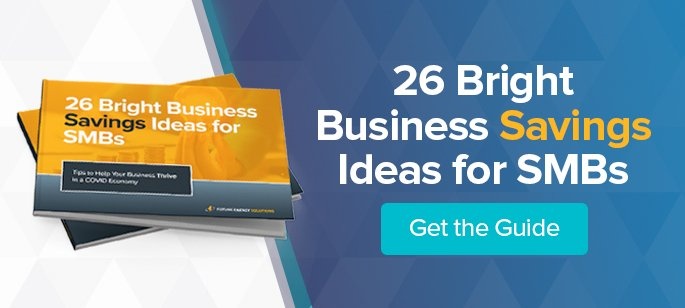SMBs (small and mid-sized businesses) and industries worldwide are dealing with the realities of the COVID-19 pandemic. It has had a huge impact on consumer behavior and spending, workplace operations, and the economy.
Among the challenges business owners face are:
- - The cost of keeping employees safe
- - Reductions in cash flow
- - Opening new revenue streams, particularly in industries like restaurants and retail
- - Costly new operating and safety procedures in warehouses, schools, gyms, prisons, and municipal buildings
If you’re a small business owner, you have a range of financial solutions. The term “disaster” is frightening (yet appropriate). However, when paired with “relief” it gives hope and ideas to businesses like yours that are, most likely, dealing with unique challenges.
Future Energy Solutions has a history of helping businesses “keep the lights on” -- literally and metaphorically with energy-efficient lighting solutions that promote business, employee and customer health. This commitment seems more important than ever as many business owners are struggling just to make payroll and keep valued team members loyal and engaged.
We’ve consulted with hundreds of business owners in the last few months to help them identify ways to get financial relief. If your business is struggling in the current economic environment, you may want to consider applying for a disaster relief program.
What is a Disaster Relief Program?
The term refers to any program designed to ease the financial burdens companies or individuals face due to catastrophic events. These occurrences include things like natural disasters, far-reaching financial downturns, and -- in this case -- widespread health emergencies.
Many disaster relief programs have been offered over the years. COVID-19 has given rise to new and valuable ones.
3 Types of Disaster Relief Programs to Help Small Businesses Recover from COVID-19
Here are three types of disaster relief programs that could help your business get through this time of crisis and give you new hope for a brighter future. Consider consulting with local business advisors to determine which program(s) are best for you. Remember to assess the long-term implications of loans and investments.
The CARES Act - Federal Small Business Relief
The CARES Act, which went into effect in March 2020, provides close to $400 billion in relief for small businesses and their employees. It includes multiple program types:
- - The Paycheck Protection Program or PPP, enables companies to keep workers on their payroll. Businesses must meet specific criteria to qualify. The requirements depend mostly on business size and apply to both for-profit and non-profit businesses.
- - Economic Injury Disaster Loans (EIDLs) and EIDL Advances give businesses emergency relief for temporary setbacks. Loans can be up to $2 million, $10k of which is forgivable. You can get guidance on how to apply here.
- - SBA Express Bridge Loans provide a lifeline for small businesses that already have a relationship with an SBA Express Lender. This is a bank or financial institution that’s been approved by the SBA. You can get up to $25K as a temporary stopgap while waiting for an EIDL to come through. Just note that the amount of the Bridge Loan will be deducted from your loan.
- - If you already have an SBA loan, you can get SBA Debt Relief to cover your payments (principal and interest) for a certain amount of time. No application is required.
The SBA website contains details about each type of program. Some of these programs are evolving, so check the site often for updates.
State and Local Programs You May Qualify For
In addition to federally-backed programs, there may be financial relief programs in your local area. This state-by-state directory details each state’s programs and qualifications. Because COVID-19 rates and their financial impact differ across the country, governors and local business associations are offering locally-relevant programs to provide funding and specific disaster relief options.
Local business associations and trade groups are rising up to support each other. They can be a great source of information and insights into the nuances of these programs.
And don’t forget the power of community. A lot of your business peers have weathered economic crises in the past. They can often share strategies that have helped their businesses survive.
Rebates, Discounts and Cash Incentives
Disaster relief doesn’t just refer to loans and payment options. Companies around the country are offering deals and discounts for both businesses and consumers. These can often unlock surprising cash flow that would have otherwise been wasted.
- - Rebates offer businesses cash back after they have already purchased a product or service. You pay up-front but reap benefits afterwards.
- - Discounts have more immediate benefit. They’re sometimes based on how much of a product you buy, when you buy it, or how long you commit to staying on as a customer. Credit card companies often offer discounts for specific brands, so now is a time to play close attention to the vendors you use.
- - Cash incentives are a unique way of making it easier for people to make purchases. Sometimes this looks like the business covering part of the cost of a product. Other times, it may be a bonus check just for closing a deal.
FES just released a cash incentive program to help business owners keep operating. We’re basically paying businesses to switch to LED. This means we’re installing energy-efficient LED lighting systems for zero capital, and then buying the old lights out right as soon as the installation is complete. The program will put thousands of dollars back into business owners’ pockets and reduce their monthly lighting bills by about 60%.
Spend Management Tips to Takeaway
No one knows for sure what the long-term impact of the COVID-19 pandemic will be. But one thing is certain: Businesses that survive crisis must know how to manage cash flow.
You need to innovate, monitor the competition, stay calm and focused, and make decisions that will enable you to survive today while keeping an eye on the future of your customers’ needs.
- - If you apply for a loan, use the money wisely.
- - Look for deals and opportunities.
- - Negotiate smartly with trusted vendors and service providers.
- - Invest in improvements that your customers and prospects will value.
- - And don’t forget to track your spending. Cloud-based programs help you monitor cash flow and spot immediate ways to save money. Having easy-to-review data will enable you to make faster, smarter decisions.
Everyone is faced with tough trade-offs these days. But making the right financial decisions now can result in decades of health and prosperity in the future.
If you need an innovative savings program, we’re here to help. Learn how you can save your business thousands.


%20(1).png?width=1080&height=1080&name=FES-Ebook-1%20(1)%20(1).png)